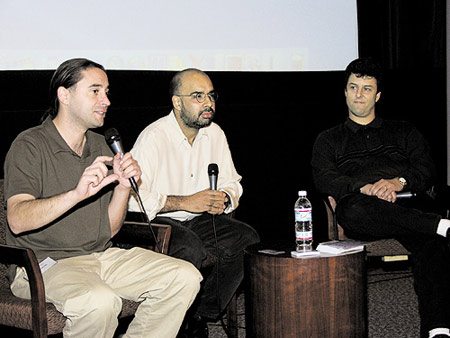By Matt Hurwitz
Can an entire theatrical motion picture be edited on a laptop computer, in the director's son's bedroom?
At the DGA's New Technologies Committee's Fast Forward! "The Ins and Outs of Desktop Editing" seminar in November, the fastest growing editing system, Apple's Final Cut Pro, was explained, for those interested in learning about making the change from Avid to a cheaper, and, in some cases, more flexible system. The presentation was made by three representatives from West Hollywood-based DigitalFilm Tree, who explained the differences between Avid and Final Cut Pro, as well as the general post-production workflow using the system. DigitalFilm Tree trains editors on the Final Cut Pro system, and has developed certified courseware for Apple.
Since its introduction in 1992, Avid has been the system of choice for film editors for offline editing. But for those whose budget doesn't afford an $80,000-$100,000 editing system, Final Cut Pro may be the answer. While Avid is a complete system, hardware and proprietary software, Final Cut Pro can be run on an Apple G4, using a variety of storage media.
The general workflow was explained, with examples given from recent films that utilized the system. Final Cut Pro can work with a great variety of media — as well as any mix of media. When working with film, the media is brought to a telecine house, which transfers it to video. During the transfer, film key codes are read from the film edge and stored with each reel. This data is then exported as a telecine log, used later by the Final Cut Pro system to identify clips. Also during the transfer, the 24 fps frame rate is translated to the 29.97 frame rate of video, using the "3-2 pulldown" algorithm.
Both the telecine log and video are then imported into the Final Cut Pro system, each in different manners. Final Cut Pro works with a computer plug-in called Cinema Tools, a relational database system that Apple purchased in 2001. The telecine log is imported to the computer into Cinema Tools, which creates a batch file. The batch file then associates itself with the video files as they are imported into the system, thus correlating each film clip file with its original film location. Once the film is edited on Final Cut Pro, a cut file is then produced by Cinema Tools to be provided to the negative cutter.

Import of the video itself is done through use of a video "capture card." The capture card is a hardware device one connects to a video deck and into a "Firewire" port on the computer, one of Apple's data ports. Any number of cards may be used, depending on the media being imported — DVCam, DigitBeta, HD, HDCam, etc. — each with different costs and functionality. The capture card can also perform another important function, "inverse telecine." It is considered desirable, when working with film, to edit in Final Cut Pro at 24 fps, since that is the frame rate of the native material whose negative will be cut. Since video runs at 29.97 fps, it must be converted back to 24 fps, something most capture cards can accomplish.
Like Avid Film Composer, Final Cut Pro has the option to edit using either uncompressed media files, which can require immense amounts of storage space, or compressed data. Popular for use with Final Cut Pro is Photo .jpg Compression, which Apple calls "Offline RT." Using Offline RT compression, an entire film can be stored on a single Firewire drive unit, the size of a Sony Walkman, with 40 minutes of film taking up only 1GB of drive space.
Once aboard, the video files are manipulated quite handily. Final Cut Pro displays several windows in which the editor works. A browser window allows the editor to organize the clips into folders/bins, and provides any variety of data about each file. Thumbnails of each clip can be scrolled through/viewed easily, and also organized in a storyboard fashion.
Clips are dragged-and-dropped onto a "timeline," a graphical representation of the sequence being assembled. Both audio and video are visible for each clip, locked together, or, if desired, separated. Up to 99 video and audio clips can be dragged onto the timeline, either inserted between, say, two existing clips, overwritten on top of existing clips, or, unique to Final Cut Pro, placed on adjacent lines within the timeline, enabling the editor to move or adjust a clip easily. More than one timeline can be opened at a time, enabling the editor to cut copy sequences from one timeline to another. There are also 99 levels of "Undo" in Final Cut Pro.
Final Cut Pro also has a color correction utility, something even veteran editor Walter Murch (The English Patient) is now utilizing on Anthony Minghella's Cold Mountain, noted Ramy Katrib. There is also a Range Check utility, which assures that blacks and whites are within legal broadcast ranges.
As mentioned, once editing is completed, the system, through Cinema Tools, can generate a cut list for use by the negative cutter. In addition, the editor can provide the editor the entire film on a CD, at Photo .jpg resolution, for reference. The project can also be output to video, through the same capture card that imported the original material. The capture device can re-insert the 3-2 pulldown it originally removed, making the program compatible with video for viewing on a standard NTSC monitor.